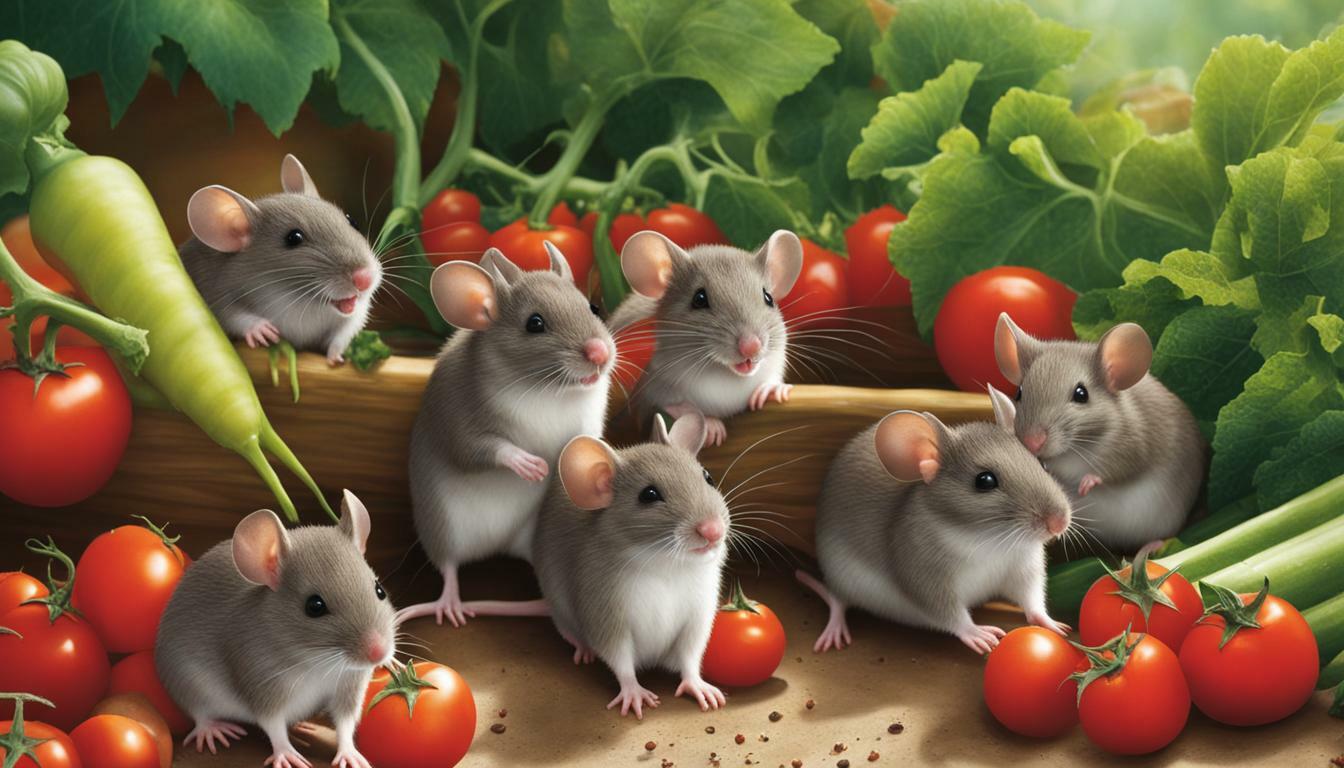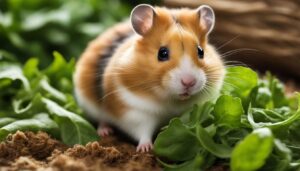Are you curious to know if mice will eat tomatoes? Understanding the eating habits of these small rodents is essential to determine the role tomatoes play in their diet.
Key Takeaways:
- Mice will eat tomatoes, including the fruit, leaves, stems, and partially moldy ones if food is scarce.
- Tomatoes should be fed to mice in moderation due to their high sugar content.
- Tomatoes contain antioxidants that can benefit the overall health of mice.
- Other fruits that mice can enjoy include apples, bananas, melons, pears, berries, and plums, but citrus fruits should be avoided.
- Protecting tomato plants from wild mice can be done by removing hiding places, using shade cloth or cages, and employing natural deterrents like herbs or mothballs.
The Diet of Mice: A Closer Look
Before we explore the specific relationship between mice and tomatoes, let’s take a closer look at the overall diet of these tiny creatures. Mice are omnivorous and have a wide range of preferences when it comes to food. They are opportunistic eaters and will consume whatever is available to them.
Mice have a particular fondness for grains, seeds, and nuts, which provide them with essential nutrients and energy. These small rodents are also known to eat small insects, worms, and even small vertebrates on occasion. They have sharp incisor teeth that allow them to gnaw on various materials, including wood and plastic.
In addition to their love for carbohydrates and protein-rich foods, mice also have a taste for fruits and vegetables. They enjoy eating a variety of produce, including tomatoes. Mice will eat the ripe fruit, leaves, and stems of tomatoes. They are even known to consume partially moldy tomatoes if they are desperate for food. However, it is important to note that tomatoes should be fed to mice in moderation due to their high sugar content.
| Food Group | Examples |
|---|---|
| Grains and Seeds | Wheat, barley, corn, sunflower seeds, pumpkin seeds |
| Protein Sources | Insects, worms, small vertebrates |
| Fruits and Vegetables | Tomatoes, apples, bananas, melons, pears, berries, plums |
While tomatoes are a tasty treat for mice, it is important to remember that their diet should be well-balanced. Too much sugar from tomatoes can lead to blood sugar issues and insulin problems over time. It is advisable to provide mice with a variety of foods to ensure they receive all the necessary nutrients for optimal health.
Other fruits that mice can enjoy include apples, bananas, melons, pears, berries, and plums. These fruits offer nutritional benefits and can be a healthy addition to a mouse’s diet. However, mice should avoid citrus fruits as they can cause digestive issues.
To protect tomato plants from wild mice, there are several strategies you can employ. Start by removing hiding places around the plants, such as debris or dense vegetation. Using shade cloth or cages can also prevent mice from accessing the plants. Additionally, you can use natural deterrents such as herbs or mothballs to discourage mice from feasting on your tomato plants.
In summary, mice have a varied diet that includes grains, seeds, protein sources, and fruits and vegetables like tomatoes. While tomatoes are a favorite among mice, it is important to feed them in moderation due to their high sugar content. Providing a well-balanced diet and taking measures to protect tomato plants can ensure a harmonious relationship between mice and tomatoes.
Mice and Tomatoes: Yes, They Do Eat Them!
If you’re wondering whether mice have a taste for tomatoes, the answer is a resounding yes! These critters are particularly fond of tomatoes, devouring everything from the fruit itself to its leaves and stems. Whether the tomatoes are ripe or partially moldy, mice will happily munch on them if given the opportunity.
But while mice enjoy tomatoes, it’s important to feed them in moderation. Tomatoes contain a high amount of sugar, and excessive consumption can lead to blood sugar issues and insulin problems over time. So, while it’s perfectly fine to treat your furry friends to some tomato goodness, be sure to offer it in controlled portions to ensure their overall health.
Antioxidant-Rich and Other Fruits for Mice
Tomatoes, despite the sugar content, do have some health benefits for mice. They are a great source of antioxidants, which can help boost the immune system and overall well-being of these small rodents. However, tomatoes are not the only fruit that mice can enjoy.
| Fruits for Mice | Safe or Unsafe? |
|---|---|
| Apples | Safe |
| Bananas | Safe |
| Melons | Safe |
| Pears | Safe |
| Berries | Safe |
| Plums | Safe |
| Citrus Fruits | Avoid |
These are just a few examples of fruits that mice can safely consume. Offering a varied diet will provide them with the necessary nutrients for a healthy life. Just remember to avoid citrus fruits, as they can be harmful to mice.
In addition to feeding mice the right fruits, it’s also important to protect your tomato plants from wild mice. Remove any hiding places near the plants, and consider using shade cloth or cages to prevent access. Natural deterrents, such as herbs or mothballs, can also help keep mice away from your precious tomatoes.
Moderation is Key: Tomato Consumption for Mice
While tomatoes can be a healthy treat for mice, it’s essential to exercise moderation when including them in their diet due to the sugar content. Mice are known to have a sweet tooth and can easily develop blood sugar issues and insulin problems if they consume too many sugary foods, including tomatoes. Therefore, it is important to offer tomatoes as a occasional snack rather than a staple food in their diet.
In addition to the sugar content, excessive tomato consumption can also lead to digestive issues in mice. Tomatoes are acidic and can cause stomach upset or diarrhea if consumed in large quantities. To prevent such problems, it is recommended to offer small, bite-sized pieces of tomato as a treat, alongside a balanced diet of lab blocks or a variety of other fruits and vegetables.
Table: Sugar Content in Common Fruits and Vegetables
| Fruit/Vegetable | Sugar Content (per 100g) |
|---|---|
| Tomatoes | 2.6g |
| Apples | 10.4g |
| Bananas | 17.2g |
| Oranges | 9.4g |
As shown in the table above, tomatoes have a relatively low sugar content compared to other fruits. However, it is important to note that a mouse’s diet should be diverse and not solely focused on tomatoes or any other specific food item. Feeding a balanced diet that includes a variety of fruits, vegetables, and lab blocks is crucial for maintaining the overall health and well-being of pet mice.
The Health Benefits of Tomatoes for Mice
Tomatoes offer more than just a tasty treat for mice – they also bring a range of health benefits thanks to their abundance of antioxidants. These powerful compounds help protect the cells of mice from damage caused by harmful free radicals, reducing the risk of various diseases and promoting overall well-being. Additionally, tomatoes are a great source of essential vitamins and minerals, including vitamin C, potassium, and folate, which are important for maintaining a healthy immune system and proper organ function.
By incorporating tomatoes into their diet, mice can enjoy improved cardiovascular health. The antioxidants found in tomatoes help to lower blood pressure and reduce the risk of heart disease. Moreover, these vibrant red fruits contain lycopene, a natural pigment that has been linked to a decreased risk of certain types of cancer in mice.
In addition to their antioxidant properties, tomatoes provide dietary fiber, which promotes healthy digestion in mice. This fiber aids in preventing constipation and maintaining regular bowel movements. Furthermore, the high water content of tomatoes helps to keep mice hydrated, ensuring proper body function and preventing dehydration-related issues.
While tomatoes are indeed beneficial for mice, it is important to remember that moderation is key. Excessive tomato consumption can lead to blood sugar problems and potential weight gain in mice. It is recommended to offer tomatoes as a treat, alongside a balanced diet that includes other fruits, vegetables, and a variety of mouse-specific food options. By doing so, you can provide your furry friends with a well-rounded and nutritious diet while still allowing them to enjoy the health benefits of these vibrant red fruits.
| Nutritional Benefits of Tomatoes for Mice |
|---|
| Abundance of antioxidants |
| Source of essential vitamins and minerals |
| Improved cardiovascular health |
| Potential cancer prevention |
| Promotes healthy digestion |
| Helps in maintaining hydration |
| Should be fed in moderation |
Other Fruits Mice Can Enjoy
Tomatoes aren’t the only fruit mice can enjoy! Discover a variety of safe and delicious fruits that can be part of a mouse’s diet. These fruits are not only tasty but also provide essential nutrients to keep your furry friends healthy and happy.
Here are some fruits that mice can safely consume:
- Apples: Mice can nibble on small, sliced pieces of apples. Just make sure to remove the seeds and core before offering them to your little buddies.
- Bananas: Mice love the sweetness of ripe bananas. Serve small pieces to avoid overindulgence.
- Melons: Watermelon, cantaloupe, and honeydew are all safe options for mice. These juicy fruits can be a refreshing treat.
- Pears: Offer small chunks of pear as a snack. Mice enjoy the mild flavor and crunchy texture.
- Berries: Blueberries, strawberries, and raspberries are all safe for mice. These tiny fruits are packed with antioxidants.
- Plums: Mice can enjoy the flesh of plums in moderation. Remove the pit before serving.
It’s important to note that while mice can enjoy these fruits, citrus fruits should be avoided. The high acidity levels in citrus fruits can upset their delicate digestive systems.
| Fruit | Notes |
|---|---|
| Apples | Remove seeds and core before serving. |
| Bananas | Offer small pieces to avoid overindulgence. |
| Melons | Watermelon, cantaloupe, and honeydew are all safe options. |
| Pears | Offer small chunks of pear as a snack. |
| Berries | Blueberries, strawberries, and raspberries are all safe options. |
| Plums | Remove the pit before serving. |
Protecting Tomato Plants from Wild Mice
Worried about wild mice munching on your precious tomato plants? Here are some effective methods to protect your crops from these sneaky nibblers.
When it comes to preventing mice from eating your tomato plants, it’s essential to create an inhospitable environment for them. Start by eliminating potential hiding places around your garden, such as tall grass, debris, or woodpiles, as these can attract mice. Clearing the area will discourage them from taking up residence near your plants.
Using shade cloth or cages can provide an additional layer of protection for your tomato plants. Covering them will not only deter mice but also safeguard against other potential threats like birds or insects. Make sure the cloth or cages are secure and tightly fitted to prevent any access points for mice.
| Natural Deterrents | Effectiveness |
|---|---|
| Herbs such as mint, lavender, or rosemary | Can repel mice due to their strong scent |
| Mothballs | Mice find the odor unpleasant and may avoid the area |
Another strategy to consider is using natural deterrents. Certain herbs like mint, lavender, or rosemary have strong scents that mice find unappealing. Planting them around your tomato plants can help deter these pests. Additionally, placing mothballs strategically near your garden can also discourage mice from approaching.
By implementing these protective measures, you can ensure that your tomato plants stay free from unwanted nibbling visitors. Remember to stay vigilant and monitor your garden regularly for any signs of mice. Protecting your crops is not only important for your own enjoyment but also for the health and success of your tomato plants.
Conclusion
In conclusion, mice do have a penchant for tomatoes, but it’s important to balance their consumption with moderation. By understanding their diet preferences and taking preventive measures, you can ensure both mice and your tomato plants thrive cohesively.
Yes, mice will eat tomatoes and they are particularly fond of them. They will eat the fruit, leaves, stems, and even partially moldy tomatoes if they are starving. However, it is important to feed them tomatoes in moderation due to the high sugar content, as too much can cause blood sugar issues and insulin problems over time.
Tomatoes are a healthy treat for mice and contain antioxidants that can benefit their overall health. Other fruits that mice can eat include apples, bananas, melons, pears, berries, and plums, but they should avoid citrus fruits.
If you want to prevent wild mice from eating your precious tomato plants, there are a few tips you can follow. Start by removing hiding places near your plants, such as piles of debris or overgrown vegetation. You can also use shade cloth or cages to physically protect your plants from these little nibblers. Furthermore, natural deterrents like herbs or mothballs can be effective in keeping wild mice away from your tomato garden.
By implementing these strategies, you can strike a balance between providing mice with their favorite snack and safeguarding your tomato plants. So remember, offer tomatoes to mice in moderation, explore other fruits they can enjoy, and take proactive steps to protect your garden. This way, everyone can coexist harmoniously in the world of mice and tomatoes!
FAQ
Will mice eat tomatoes?
Yes, mice will eat tomatoes and they are particularly fond of them. They will eat the fruit, leaves, stems, and even partially moldy tomatoes if they are starving.
How should I feed tomatoes to mice?
It is important to feed them tomatoes in moderation due to the high sugar content. Too much tomato consumption can cause blood sugar issues and insulin problems over time.
What are the health benefits of tomatoes for mice?
Tomatoes are a healthy treat for mice and contain antioxidants that can benefit their overall health.
Are there other fruits mice can eat?
Yes, mice can also enjoy fruits such as apples, bananas, melons, pears, berries, and plums. However, they should avoid citrus fruits.
How can I prevent wild mice from eating my tomato plants?
To protect your tomato plants from wild mice, you can remove hiding places, use shade cloth or cages, and employ natural deterrents like herbs or mothballs.




